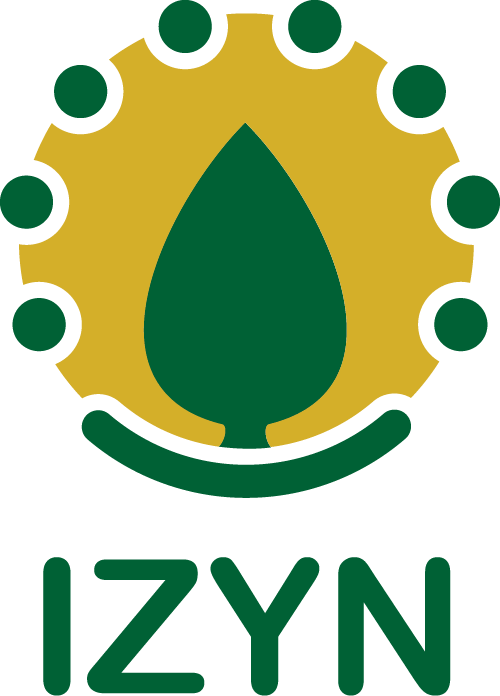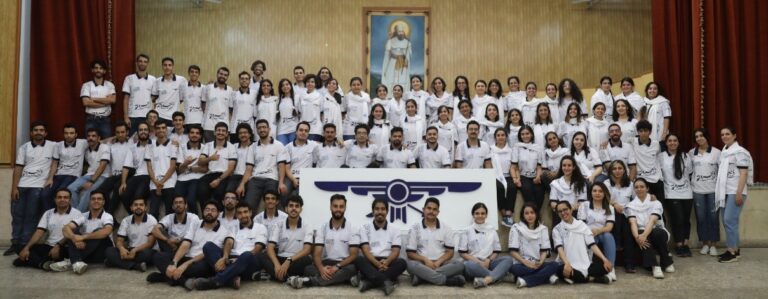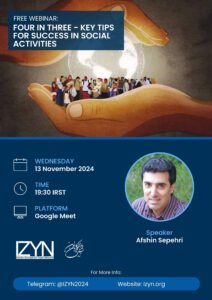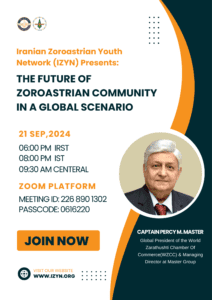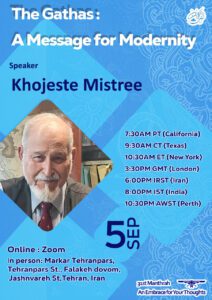The Zoroastrian Students Association, founded 55 years ago in Tehran, is one of the largest and most active organizations in the Zoroastrian community in Iran. Each year, they organize various events related to arts, culture, science, sports, and religion for Zoroastrians across Iran. One of these events is Manthrah, the largest religious gathering of Zoroastrians in Iran.
It was held this year for the 31st time, from September 4th to 6th, 2024, at Markar Tehranpars in Tehran. Manthrah has been held annually since 1993, including during the COVID-19 pandemic when it was conducted online for three years. Each year, there is a special slogan, and the 31st Manthrah is held with the slogan “Manthrah: An Embrace for Your Thoughts.”
History of Manthrah
The first Manthrah began during a time when the traditional Zoroastrian script, Din Dabireh, was fading from practice. Except for a few Mobeds (Zoroastrian priests), very few Zoroastrians were proficient in reading the Gathas. Thus, the Manthrah Avesta Recitation competition was initiated, alongside the Gatha Studies and article-writing sections, with the goal of promoting the understanding of this divine message.
From the second year, the necessity of teaching Din Dabireh to achieve the seminar’s aims became evident. Consequently, despite many challenges, the teaching of this script to the youth began. The late Ms. Shahnaz Shahzadi’s continuous efforts in the province of Yazd laid the foundation for the cultivation of Gatha reciters. From the third seminar onwards, there was significant growth in participation, with nearly 100 participants taking part in the preliminary round in Yazd alone, signaling a major step toward spreading the profound message of the Gathas.
During this period, thanks to the relentless efforts of the late Dr. Kasra Vafadari, the Gatha Studies and article-writing sections expanded to provide a platform for our youth to express their thoughts about the Gathas’ inspiring hymns. Shortly after the seminar’s inception, it gained the support of prominent figures such as the late Mobed Rostam Shahzadi and the late Mobed Jahangir Oshidari. Over time, the seminar also earned the full backing of the Zoroastrian Mobed Council.
The Zoroastrian Students Association continues to organize Manthrah with the goal of spreading and deepening the understanding of the Gathas’ message, focusing on Avesta recitation and Gatha Studies.
Welcome to Manthrah 31
The event lasts five days, with three days open to the public, while the first and last days are reserved for participants. During these days, participants aged 10 and up from all over Iran gather at Markar Tehranpars, where around 100 Zoroastrian student organizers arrange a camp with various activities.
Currently, the seminar comprises two main sections: Avesta Recitation and Gatha Studies. In the Avesta Recitation section, participants recite the Gathas with beautiful intonation. In the Gatha Studies section, researchers explore various topics related to the Gathas, traditions, culture, and customs of the Zoroastrian religion and Iranian civilization. Awards are given to the best participants, who are assessed by committees, and the event is funded by Iranian Zoroastrian donors.
Each year, participants also take part in the five-day Manthrah educational camp, which includes participants aged 10 to 18. During this five-day educational camp, participants in Manthrah acquire soft skills such as teamwork, communication, creativity, and social activities. Additionally, since the participants come from different cities, they visit famous Zoroastrian landmarks in Tehran and become familiar with them.
Manthrah 31 Statistics
The number of participants who were accepted through the preliminary round and entered the final. They are listed by city:
• Tehran: 31 participants
• Yazd: 43 participants
• Kerman: 14 participants
• Shiraz: 3 participants
• Karaj: 2 participants
• International: 1 participant
IZYN’s Contributions to Research, Youth Engagement, and Global Connectivity at Manthrah 31
-
The past, present, and future of Iranian Zoroastrian culture and economy
Radman Khorshidian and Parisa Foroudian from the Iranian Zoroastrian Youth Network (IZYN) participated in the Gatha Studies section. They conducted research on the past, present, and future of Iranian Zoroastrian culture and economy and presented it at the Manthrah festival. They used Causal Layered Analysis (CLA) to examine the contemporary Zoroastrian community in Iran, focusing on the events, trends, values, and narratives that have influenced this community over the past 200 years.
The importance of this research lies in developing a deeper understanding of the social and cultural structures of this community, which can inform and guide future changes. The method used is a redesign of CLA centered on the concept of “extended nows,” applied to analyze a community and a longer time span.
The findings show that this method not only helps in understanding the history and developments of Zoroastrians but also provides an opportunity to reconsider the community’s values and cultural system. The article concludes that understanding the various layers of the Zoroastrian community, from surface levels to deeper layers, is essential for transforming and improving the community’s future.
In conclusion, a comprehensive understanding of the Zoroastrian community’s layers—from its visible surface aspects to its deeper, more nuanced cultural and social dynamics—is essential for guiding future transformations. Key findings highlight the need to address declining participation in community events and the growing social withdrawal, which threaten the community’s cohesion and development.
In the Gatha Studies section, Zoroastrian thinkers are invited to discuss religious and social issues in the community. This year’s topic was the reasons for social withdrawal. The panel members and attendees shared their views and examined the decline in participation at community events. Radman Khorshidian, a member of IZYN, was also invited to this meeting and spoke about the network’s activities to increase youth participation among Zoroastrians include some examples.
-
The Gathas: A Message for Modernity
This year marked the first time that Manthrah hosted a global section, allowing Zoroastrians from around the world, particularly Parsees, to participate. The Zoroastrian Students Association, in collaboration with IZYN, hosted an international lecture for Zoroastrians worldwide. This lecture, presented by Khojeste Mistree in English, was accessible globally via Zoom, especially for Parsees. Additionally, community members attended in person at Markar Tehranpars in Tehran, Iran. About 50 people joined via Zoom, and others attended in person. The event started at 6:00 PM Iran time on September 5th, 2024
Khojeste delivered a lecture titled “The Gathas: A Message for Modernity.” He talked about Zoroastrian history, the nature of God, Zoroastrian beliefs, Ahura Mazda as the Lord of Wisdom, the Amesha Spentas and the seven creations, and how important it is to care for them and be ecologically conscious. He emphasized that it is our duty as Zoroastrians to promote happiness for ourselves and others. The lecture was followed by a Q&A session where both in-person and online audiences asked questions that Khojeste answered. The session was well-attended and lasted for 90 minutes.
It was a memorable event for Manthrah in its 31-year history. Finally, we Zoroastrians gathered in Manthrah from all around the world, especially Parsees. We hope that this gathering will increase in the future. We can talk and listen to each other, discuss our history, beliefs, and thoughts, share them, learn about our differences, find common values and expand them, learn from one another and make progress. Returning to our roots, embracing our own thoughts and those of others, and building a strong, large community of Zoroastrians worldwide, ensuring that nothing can ever distance us. We look forward to fostering a dialogue between the Zoroastrian Students Association (which includes undergraduate and graduate students), the Iranian Zoroastrian Youth Network, and other Zoroastrian communities, especially youth, to expand our community.
Acknowledgments: We thank Nima Khademi and Parsa Rashidi (members of the Zoroastrian Students Association) for providing information and photographs of Manthrah 31.
